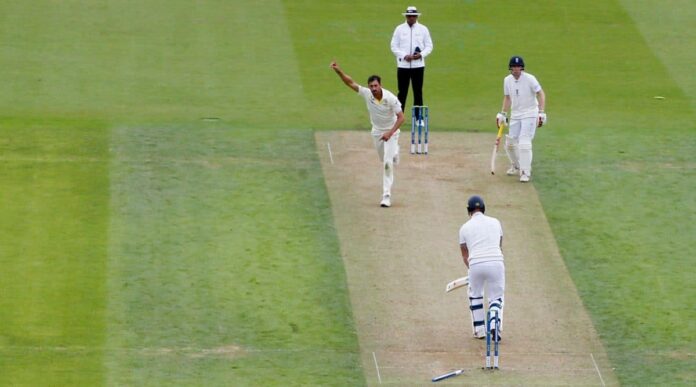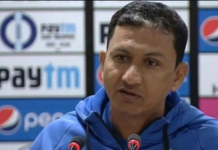The moment required a spark, a burst of magic. It’s when Mitchell Starc nudges into your consciousness. For most of the match, he has been invisible; ineffective. He gloriously wasted the new-ball, unable to tame the swing under sinister skies. The first seven overs were like a rookie’s —nervous and erratic, 44 easy runs came off his first seven, and he did not look like someone with 325 Test scalps in his register. He was condemned to the edge of the fence, his morning largely spent in the company of England fans.
India pulls out of games in China over stapled visas for Arunachal athletes
But when the moment for magic arrives, the eyes wander towards Starc. For much of the second session, Harry Brook and Moeen Ali had cut Cummins and his colleagues to ribbons, rollicking 111 runs in just 18 overs in their fourth wicket-stand. But a limping Ali had perished, bestowing the visitors a fortunate breakthrough and a slim ray of hope. But strode in Stokes. And Cummins spared no dilemma in signaling Starc to loosen his limbs and joints. It was a critical juncture of the match — England were strolling, Australia were panicking, short of both ideas and inspiration.
Often in such situations in this series, where there is no clarity or strategy, Cummins turns to Starc. This series, when Cummins has often been unusually chaotic and Josh Hazlewood uncharacteristically wayward, Starc has been the man to produce moments out of nowhere, from nothing. In the lost cause of Headingley, he alone threatened to rewrite the script.
So he steamed in, his tail up, his long legs hitting the crease hard, the promise of magic swirling in the air. His left shoulder was bandaged, the rigours of the series taking its toll. But here he was, for one more spell of bone-crushing energy. The first eight balls were non-events, standard good-length balls, either angling across the right-handed Brook or shifting down the leg to the left-handed Stokes. In the first session, he was striving too hard to swing the ball, over-stretching to conjure the unplayable ball. Here he was inclined to chisel a tight length, figure out the perfect line. When Stokes came to bat, his idea was clear, double-bluff him with the in-ducker and away-goer. The first ball was full on leg, he squirted the ball for a single. The second was full on off-stump that Stokes crunched powerfully to cover. The third slid past Stokes’s leg and could have reached the fence but for the reflexes of Alex Carey. In hindsight, Starc would have deliberately strayed down the leg, encouraging Stokes to go leg-side.
Apple Foldable iPad Could Be A Reality Soon: What To Expect
Then arrived the moment of near-magic because Starc has bowled balls of more magical nature, well to dismiss the same batsman. In the 2019 World Cup, he produced a wondrous ball to disarray the stumps of Stokes. The ball wobbled away, curled in and deviated just a fraction away off the surface at blistering pace. This one was bereft of such dramatic visual effects; rather angled in and seamed away after landing to hammer his stumps.
Stokes was stunned. His team would freeze, imploding in the 90’s fashion, with Jonny Bairstow and Brook too back in the dressing room for the addition of 19 runs.
From 184/3, England, like Australia in the first innings in Manchester, sank to 212/7. Such a moment lifts the team — from a disenchanted, sloppy group that spilled three straightforward catches, they were ratcheting up the intensity, fielding desperately, saving every run and piling the pressure on England’s batters.
Josh Hazlewood suddenly found movement in the air, and purchased inward movement to castle Jonny Bairstow, the latter thick-edging to the stumps. The concentration of Brook too snapped and he flashed at a widish ball to second slip.
Brook’s dismissal was not spectacular, nonetheless more important than that of Stokes. His batting captures the essence of Bazball, capturing all its magic and magnificence, volatility and vulnerabilities. For much of his 85 off 91 balls, he lived dangerously yet was assertive. He mis-sliced and miscued, edged and groped, yet he essayed strokes that marveled, shots that not just burned the grass but dizzied the heart and brain of Australia’s fast bowlers.
Bowlers, even as skilled and experienced as Cummins, Hazlewood and Starc, fell apart. In the first hour of the second session, he and Ali ransacked 40 runs in 20 balls. A similar wave of counterattack before lunch had helped England recover from losing three wickets in the space of making eleven runs. He plundered 35 runs off 23 balls in that spell of furious run-making, including a slap-on-your-face kind of pulled-six, leading into lunch and reversed the momentum after England lost three wickets while adding 12 runs. A few more overs, and he would have wreaked more havoc on the Australian bowlers.
Typically, England did not surrender. Chris Woakes and Mark Wood tangoed for 49 valuable runs, before Woakes added 22 with the last pair to end England’s first innings on 283. The demolisher of the tail, again, was Starc, who is enjoying his best Ashes in England. His previous three trips—as understudy, spearhead and passenger in that order—had fetched him just 33 wickets at 31.4. In this series, he has picked 19 at 27.5, managing his best wickets-haul, average and strike rate (34). En route, he has produced some semi-magical balls too.
.








